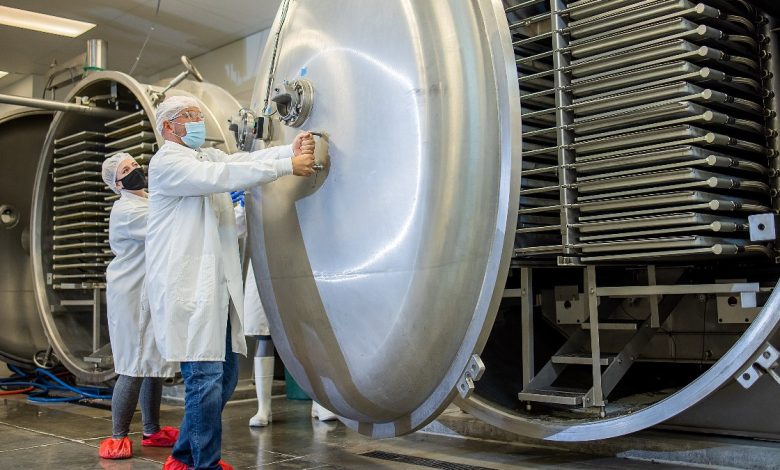Introduction
Freeze drying is a process of removing water or moisture from a product by sublimation. The process involves freezing the product at very low temperatures and then removing the ice or water by applying heat in a vacuum environment. This article provides a complete guide to freeze dryers, including their working principles, types, applications, benefits, equipment, maintenance, safety considerations, and comparison with other drying methods.
What is a Freeze Dryer?
A
freeze dryer, also known as lyophilizer, is a device that removes water or moisture from a product by sublimation. The process involves freezing the product at very low temperatures and then removing the ice or water by applying heat in a vacuum environment. The result is a dry product that retains its original shape, size, and color.
How Does a Freeze Dryer Work?
A
freeze dryer works by sublimation, which is the process of changing a solid into a gas without passing through the liquid phase. The process involves three stages: freezing, primary drying, and secondary drying.
In the freezing stage, the product is placed in the freeze dryer chamber, and the temperature is lowered to below freezing point. The water in the product freezes and forms ice crystals.
In the primary drying stage, the pressure in the chamber is lowered, and heat is applied to the product. The ice crystals sublimate and turn into vapor, which is removed by a vacuum pump.
In the secondary drying stage, the remaining water molecules are removed by increasing the temperature of the product. This stage is critical in ensuring the stability and shelf-life of the final product.
Types of Freeze Dryers
There are two main types of freeze dryers: laboratory-scale and industrial-scale.
Laboratory-scale
freeze dryers are used for research and development purposes and are typically smaller in size. They are ideal for small batches of products and can be used to optimize the
freeze drying process.
Industrial-scale
freeze dryers are used for commercial production and are typically larger in size. They can handle large batches of products and can run continuously for extended periods.
Applications of Freeze Dryers
Freeze dryers are used in a wide range of industries, including food, pharmaceuticals, biotechnology, and cosmetics.
In the food industry,
freeze drying is used to preserve food products such as fruits, vegetables, and meats. The process helps to retain the nutrients, flavor, and texture of the food while increasing its shelf-life.
In the pharmaceutical industry,
freeze drying is used to produce stable and long-lasting drugs, vaccines, and other medical products. The process helps to maintain the efficacy of the products and reduce the risk of contamination.
In the biotechnology industry,
freeze drying is used to preserve bacteria, viruses, enzymes, and other biological materials. The process helps to maintain their viability and activity.
In the cosmetics industry,
freeze drying is used to produce stable and long-lasting products such as creams, lotions, and powders. The process helps to maintain the texture and appearance of the products.
Benefits of Freeze Drying
Freeze drying offers several benefits over other drying methods
Some of the benefits of freeze drying include:
- Preservation of the product quality: Freeze drying helps to preserve the original color, shape, texture, and nutritional content of the product. This is because the process does not involve high temperatures or pressure that can damage the product.
- Extended shelf-life: Freeze drying removes the moisture content of the product, which is the main cause of spoilage. This increases the shelf-life of the product, making it suitable for long-term storage.
- Reduction of transportation costs: Freeze-dried products are lightweight and have a longer shelf-life. This reduces transportation costs and makes it easier to export the products to different parts of the world.
- Easy rehydration: Freeze-dried products can be easily rehydrated by adding water. This makes them convenient to use and increases their versatility.
Freeze Drying Process
The freeze drying process involves several steps, including:
- Pre-freezing: The product is frozen to a temperature below its triple point to form ice crystals.
- Primary drying: The pressure in the chamber is lowered, and heat is applied to the product to sublimate the ice crystals.
- Secondary drying: The remaining water molecules are removed by increasing the temperature of the product.
- Packaging: The final product is packaged in airtight containers to prevent moisture uptake.
Factors Affecting Freeze Drying
Several factors can affect the freeze drying process, including:
- Product formulation: The formulation of the product can affect the freeze-drying process. Factors such as pH, viscosity, and sugar content can affect the freezing and drying rates.
- Temperature: The freezing and drying temperatures can affect the quality and stability of the final product. Too high or too low temperatures can result in suboptimal product quality.
- Pressure: The pressure in the freeze dryer chamber can affect the rate of sublimation and the quality of the final product.
- Drying time: The drying time can affect the quality and stability of the final product. Longer drying times can result in increased product degradation.
Freeze Drying Equipment
Freeze drying equipment includes the following components:
- Freeze dryer chamber: This is where the product is placed for freeze drying.
- Vacuum pump: This removes the water vapor from the chamber during the drying process.
- Condenser: This collects the water vapor that is removed from the chamber during the drying process.
- Heating coils: These are used to apply heat to the product during the drying process.
Maintenance of Freeze Dryers
Proper maintenance of
freeze dryers is essential for ensuring their optimal performance and longevity. The following are some maintenance tips for freeze dryers:
- Regular cleaning: The freeze dryer chamber, vacuum pump, and condenser should be cleaned regularly to prevent contamination.
- Calibration: The temperature, pressure, and vacuum gauges should be calibrated regularly to ensure accurate readings.
- Lubrication: The moving parts of the freeze dryer should be lubricated regularly to prevent wear and tear.
Common Issues with Freeze Dryers
Some common issues with freeze dryers include:
- Condenser overload: This occurs when the condenser is unable to remove all the water vapor from the chamber, leading to a buildup of ice.
- Leakage: This occurs when there is a leak in the vacuum system, which can affect the drying process.
- Uneven drying: This occurs when the product is not evenly distributed in the freeze dryer chamber, leading to uneven drying rates.
Safety Considerations when Using Freeze Dryers
Freeze dryers can pose several safety risks if not used correctly. The following are some safety considerations when using freeze dryers:
- Electrical safety: Freeze dry
Safety Considerations when Using Freeze Dryers
Freeze dryers can pose several safety risks if not used correctly. The following are some safety considerations when using freeze dryers:
- Electrical safety: Freeze dryers are powered by electricity and can pose a risk of electric shock if not used correctly. Ensure that the freeze dryer is properly grounded and that all electrical connections are secure.
- Chemical safety: Some products that are freeze-dried can be hazardous or toxic. Ensure that the product being freeze-dried is safe for use and that appropriate safety measures are in place.
- Personal protective equipment (PPE): The use of PPE, such as gloves and safety goggles, can protect against exposure to hazardous materials.
- Fire safety: The use of heat during the freeze-drying process can pose a risk of fire. Ensure that the freeze dryer is placed in a well-ventilated area and that appropriate fire safety measures are in place.
Conclusion
Freeze drying is a useful technique for preserving the quality and extending the shelf-life of products. The process involves several steps, and the quality of the final product can be affected by several factors. Proper maintenance of freeze dryers is essential for ensuring their optimal performance and longevity, and safety considerations must be taken into account when using them.
FAQs
- Can freeze-drying be used for all types of products? A: No, freeze-drying is not suitable for all types of products. The product formulation and characteristics must be considered before using freeze-drying.
- How long does the freeze-drying process take? A: The freeze-drying process can take several hours to several days, depending on the product and the freeze dryer’s capacity.
- Is freeze-dried food healthy? A: Yes, freeze-dried food is healthy as it preserves the nutritional content of the product.
- How should freeze dryers be stored when not in use? A: Freeze dryers should be stored in a dry and cool place when not in use.
- Can freeze-dried products be rehydrated using liquids other than water? A: Yes, freeze-dried products can be rehydrated using other liquids, such as milk or juice.
For more blog
click here





